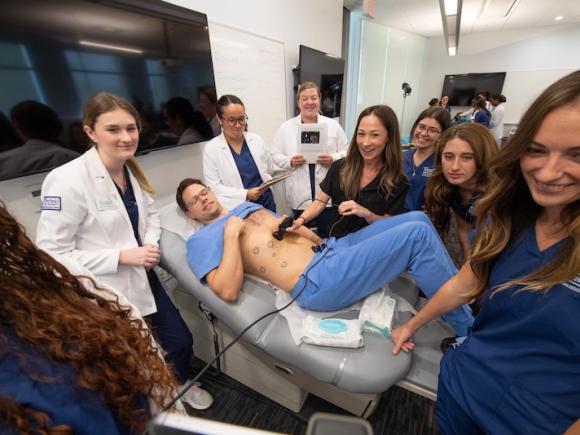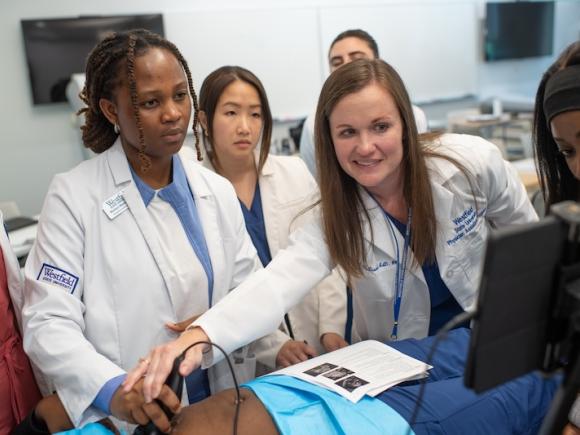
Westfield State's Physician Assistant Program Leads with Cutting-Edge Ultrasound Technology

Students practiced using the new Butterfly point-of-care ultrasound (POCUS) machines in a class workshop.
Chelsea Robitaille, Chair of Admissions for Westfield State University’s Physician Assistant (PA) Graduate Program and Assistant Professor, has a rich background in emergency medicine and urgent care. Her journey into academia began after completing a year-long residency in emergency medicine, where she fell in love with the dynamic environment of academic hospitals. The ability to teach and engage with medical students during their rounds captivated her, eventually leading her to specialize in ultrasound and become a guest lecturer at Westfield State.
Drawn to the University’s physician assistant program as a guest lecturer, Robitaille transitioned to a full-time role in 2021. Reflecting on her teaching experience, she shared, “I loved the gratification of, ‘Hey, let me tell you about some information you might have read about, but that I can give to you in a real-life way.’ The students here are super driven and really engaged… it’s just awesome.”
This year, the PA program received four Butterfly point-of-care ultrasound (POCUS) machines, significantly enhancing the hands-on learning experience. These portable devices, small enough to fit in a pocket, represent a revolutionary advancement in ultrasound technology. Introduced in 2018, POCUS tools have transformed ultrasound medicine by making it more accessible and convenient, particularly in PA programs across the country.

“Every Thursday, I teach patient assessment, which involves learning the physical exam, how to approach a patient with different disease processes, and the diagnostic or management strategies for those processes,” Robitaille explained. “Point-of-care ultrasound machines are something that providers have full control over and can use in real time. There’s no radiation, so it’s really safe, and it can give us a ton of information really fast.”
The introduction of POCUS into the program allows students to explore their own anatomy and organs, engaging them in an interactive and immersive way. “It’s been a huge game changer for us,” Robitaille added. “It’s been a huge game changer for us,” Robitaille added. “I think it’s really exciting for the faculty too, since they get to teach a new skill. I love to bring new things to our curriculum because it’s also engaging for me when I show them what it’s like to be a real, practicing clinical provider rather than just this conceptual idea.”
Thanks to an earmark grant, which provided targeted funding to various health sciences programs, the PA program was able to acquire the POCUS technology. With only 30 students, the program relies heavily on access to advanced technology and equipment, making this grant crucial to its success. Already, students have made significant strides in developing their ultrasound skills.

“The students have rapidly developed their ultrasound skills,” Robitaille commented. “From the beginning, they used to ask, ‘where do I put the gel now?’ They were scanning each other without any direction, and in an event that we just did with high school students interested in healthcare, our students showed them all sorts of scans, from echocardiography to bladder scans to looking at the abdominal aorta. It was wonderful to see that their skills have developed so much that they’re at a point now where they can teach other people that have zero experience in ultrasound. I’m really proud of them.”
The POCUS tools were quickly integrated into the curriculum, a move that enhanced the traditional didactic learning experience, which typically lasts about a year. Because the program’s curriculum is module-based, students learn one organ system at a time, with POCUS enabling ultrasound scans to be incorporated into every module.
“It’s very much embedded into every course,” Robitaille noted. “It’s nice in that way, because I’m teaching the exam that corresponds to that module, and then they’re learning the ultrasound scans which correspond to the same module as well.”
Westfield State University is leading the way by being the first in the country to offer POCUS tools in its PA program. Robitaille emphasized that the program is “ahead of the curve,” a distinction that will help produce highly skilled and well-rounded graduates. “Technology and medicine rapidly evolve. That’s just medicine, and that’s why a lot of us stay in it… it’s never boring. This is just as exciting for our students as it is for the faculty.”


